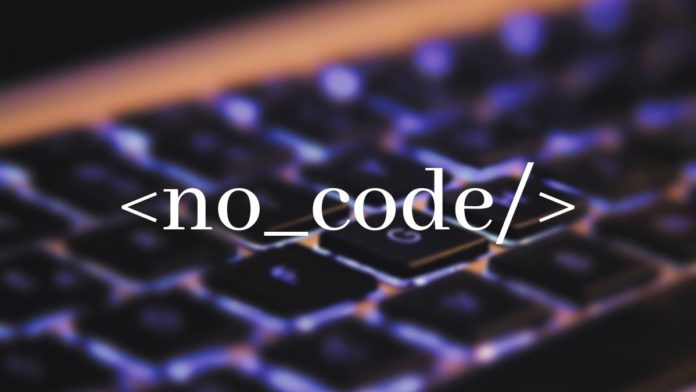Since the advent of artificial intelligence (AI) as a theoretical concept or a movie trope, the technology has progressed leaps and bounds, accommodating every primary industry’s needs. Be it finding the protein structure of genetic disorders, recommending our next binge, or ensuring streamlined claims processing; artificial intelligence has transformed most of the sector. However, while the rapid adoption of its technologies fuel disruption and innovation, there has been immense demand for professionals with AI expertise to push such changes. This resulted in the software sector lagging behind due to the scanty availability of candidates that fit the job descriptions. Imagine the few percentages of people with coding skills designing AI solutions that possess the power to revamp our world with its offerings. This void in the job market led to the growth of no-code AI platforms and tools.
Meanwhile, because coders make up such a tiny fraction of the population, the software they create risks being inherently discriminatory and biased. A diversified staff is necessary to avoid racial and gender prejudice in AI products. Not only that but people with disabilities should be included in the application design process to make it accessible. However, understanding how to code generally necessitates a higher education, and access to this knowledge is thus another obstacle to inclusion. Further, the scarcity of an adequate talent pool creates fierce competition among different industry niches to hire the ‘qualified’ by luring higher pay; thus widening the gap between demand and availability. These bottlenecks are also addressed when no-code platforms offer to fill the vacuum by enabling anybody to create an app. Most of these non-code tools have a visual appeal that allows even non-coders to develop AI-based solutions.
No coding-backed solutions have made it easier for individuals and businesses to experiment with artificial intelligence areas like data science or technologies like machine learning. These tools let organizations deploy AI models quickly and inexpensively, allowing their domain experts to benefit from them. At the same time, it has also reduced development time by a huge margin. Earlier the process of developing proprietary AI solutions involved writing code, cleaning data, classifying, organizing data, training, and debugging the model. This takes a lot longer for people who aren’t familiar with data science.
The new no-code platform can now uncover new insights and help build predictive models faster thanks to a refined user interface and integrated approach. For instance, in data analytics, no-code platforms can employ various data sources to test millions of hypotheses to identify previously unknown market drivers and restraints, and scenario outcomes. Then they can explain the findings in human-readable language or visual format – all without the use of code and in an automated manner. No coding platform, such as the DataRobot app builder, is used to create artificial intelligence and robotics applications. Without requiring any code, the platform allows users to instantly transform any model into an AI or robotics application for end customers.
Because of the rising skill scarcity, no-code platforms are likely to become more popular in the future years, with Gartner estimating that by 2023, 65 percent of app development would be low-code/no-code.
Nenshad Bardoliwalla, chief product officer of DataRobot, recently spoke with TechTalks about the difficulty of serving the demands of machine learning and data science in various industries, as well as how no-code platforms are democratizing artificial intelligence. DataRobot and other no-code AI platform providers, according to Bardoliwalla, are developing tools that allow domain experts and business-savvy people to create and deploy machine learning models without having to write code. Users can submit datasets to DataRobot, complete essential preprocessing procedures, choose and extract features, and develop and compare a variety of machine learning models, all through a user-friendly graphical user interface.
Read More: Microsoft Debuts Z-Code MoE AI to Enhance Microsoft Translator
Bardoliwalla points out that until almost a decade ago, an organization’s ability to query data and generate reports was confined to a few employees with the expert coding skills required to maintain databases and data warehouses. However, today’s tools have progressed to the point where non-coders and non-technical persons can conduct the majority of their data querying jobs using simple graphical tools without the need for experienced data analysts. Bardoliwalla assures that no-code AI is not a replacement for the expert data scientist. However, it enhances machine learning productivity across the organizational spectrum, allowing more individuals to fabricate AI-powered models. This alleviates much of the responsibility on data scientists’ shoulders and allows them to refocus their talents on other crucial tasks.
Apart from DataRobot, no-code AI services like Akkio, Obviously.ai, Levity, Clarifai, Amazon SageMaker, Peltarion, and Veritone, are also catering to the industry demand for no-code tools. Some of them also provide no-code tools for computer vision, natural language processing, and other important AI technologies.
To recapitulate, leveraging no-code platforms can solve accessibility, usability, speed, affordability, and scalability issues faced by organizations. These platforms enable workers at all levels to interact and contribute from a business standpoint, promising innovation from ‘scratch.’


